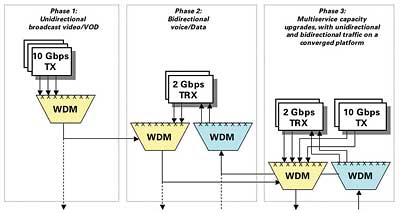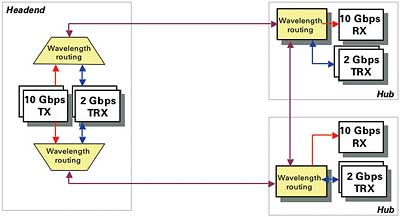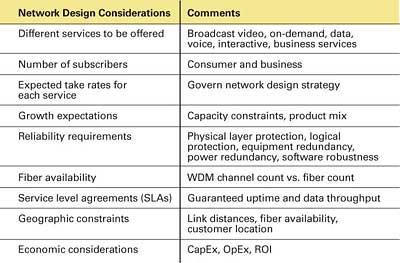Transparent Networking:
It’s not your father’s cable network any more. The relative simplicity of one-way video has given way to the complexities and varying requirements of video, voice, data and emerging services—and how to manage all these disparate services quickly becomes critical. It may boil down to a question of transport. The convergence of video, voice and data traffic onto a unified transport platform is a primary objective of today’s cable operators. Network convergence enables service providers to leverage technical and economic benefits in the highly competitive race for triple-play service delivery and bolsters cable’s advantages over direct broadcast satellite (DBS) and telco challengers. If properly designed, converged networks can offer the best of both worlds—high reliability and low cost. Regardless of traffic mix, distance, reliability requirements or anticipated growth, the common denominator in today’s multiservice networks is transport. A well-designed, robust and scalable transport infrastructure is imperative to meet quality of service (QoS), provisioning, economic and growth requirements of service providers. Transport requirements are evolving as new ways to manage diverse traffic types from the network core to the customer premises are being devised. (See Table 1.) As networks grow in complexity, transport solutions must become not only more reliable and flexible, but also easier to manage and control. Best-practices engineering strategies that will enable cost-effective, reliable triple-play service are evolving, and committed vendors are working hand-in-hand with cable operators to deliver transport solutions that can support their capacity and traffic mix requirements well into the future. Emerging transport solutions that offer reliability, control, and "transparency"—high robustness with minimum "hands-on" intervention required—are reshaping the way that converged networks are being designed. Enter GigE Gigabit Ethernet (GigE) is the ideal transport approach to reliably and efficiently deliver multiple converged services to a wide variety of consumers and business customers. Originally intended specifically for local area networks (LANs), GigE is now the protocol of choice for longer distance, higher capacity applications. Rapidly growing numbers of long-haul, regional and metro deployments have demonstrated GigE’s viability as a highly reliable, flexible and cost-effective networking solution—exactly what cable operators needed to maintain a competitive edge over other service provider competitors. Coupled with wavelength division multiplexing (WDM), switching/routing capability, efficiency-improving protocols such as resilient packet ring (RPR), and advances in network management and control, GigE represents the most promising pathway to truly transparent networking. With GigE validated as the transport approach of choice, focus now has shifted to the evolution, design and deployment of more advanced networking architectures that will allow GigE/WDM solutions to meet the needs of tomorrow’s networks. Video, voice and data—the components of the triple play—are markedly different in their data throughput, reliability and distribution characteristics. Throw emerging business services products into the mix and the task of designing a network to support broadcast video, video-on-demand (VOD), data and voice over Internet protocol (VoIP) can be a challenge. Engineers must ensure that their network deployments are futureproof while offering reliability and robustness for mission critical connectivity. Key topics Key topics to consider are reliability, scalability, dynamic bandwidth provisioning and allocation, network management and control, future applications requirements, and economy. Let’s examine each in turn. Reliability—The telcos’ claim to fame has always been their carrier class networks. As cable operators continue to roll out VoIP and data services, customers will expect reliability and availability performance in line with telco offerings. Today’s GigE technology can provide the reliability expected of circuit-switched technology, but with the economy and flexibility of a packet-based approach. At the transport level, both physical-layer and logical protection can be combined creatively to maximize network robustness without the expense and constraint of a circuit-switched approach. Scalability—With multiple services and diverse demographics, cable operators must deploy transport solutions that meet a wide variety of requirements in a single, scalable solution. The ability to scale both optically and electronically ensures that capacity can be added incrementally with minimum expense and no network downtime. Today’s GigE product offerings provide unprecedented electronic scalability. (See Figure 1.) With solutions commercially available that readily scale from 1 Gbps to 10 Gbps per wavelength, service providers can deploy the capacity required for today `s services and maintain the option to scale network capacity as demands increase in the future. Combine this electronic scalability with advances in dense wavelength division multiplexing (DWDM) and coarse wavelength division multiplexing (CWDM) technology such as scalable channel counts, on-demand wavelength provisioning, reconfigurable optical add/drop multiplexing, and dynamic channel power equalization, and the ability to offer tailor-made solutions for a diverse array of network requirements is possible. Dynamic bandwidth provisioning and allocation—A major advantage of transport solutions that rely on GigE/WDM technology is the ability to leverage true dynamic provisioning and allocation. Cable’s WDM networks historically have been static, with over-provisioning required to ensure reliable narrowcast services QoS. Typically, narrowcast services granularity was at the wavelength level, with fixed wavelength routing optics managing the static network deployment. New GigE/WDM solutions offer multiple degrees of provisioning freedom—the ability to reallocate at the wavelength or trunk level, combined with the ability to provision at the packet level. Emerging standards such as RPR (IEEE 802.17) allow traffic prioritization schemes that further improve capacity utilization efficiencies. Network management and control—Major advances in network management and control are enabling true transparent networking. Transport solutions are now available that are so reliable and easy to manage, service providers can forget they’re in place. System and component monitoring at the packet and wavelength level enables a proactive approach to transport management, where emerging problems can be detected and corrected before the customer ever experiences them. These cutting-edge management and control platforms, combined with physical layer technologies such as protection switching, automatic power balancing and tunable optics, are enabling ultra-high reliability with minimum human intervention—true transparency at the transport level. Future applications requirements—Cable companies have successfully made the transition from basic broadcast video services to advanced multiservice transport. (See Figure 2.) As operators have invested heavily in their transport infrastructures to support network convergence, service reliability has improved dramatically. The best-practices engineering philosophies that have driven this transformation put cable operators in a very favorable position with a robust, reliable network that can be leveraged for numerous future services. Future applications targeted at the business market can drive additional revenues and profits for years to come. Business connectivity for voice, data and video services, as well as emerging services such as storage transport and virtual private networks (VPNs), require guaranteed service levels. Today’s GigE/WDM solutions provide the necessary reliability as well as a variety of hardware and software options that enable seamless, standardized connectivity from the network core to the customer premises. Economy—When considering transport solutions, technology considerations can be the most obvious decision drivers, but economics can prove to be much more important. The advantage that GigE/WDM can provide cable is a cost-effective method of delivering multiple services with proven reliability. Not only have hardware and software costs been demonstrated to be attractive, but opex costs are also very favorable because of the simple but robust transport approaches that GigE/WDM solutions offer. Paradigm shift GigE/WDM transport is enabling a paradigm shift in the design and deployment of today’s converged-services networks. This shift will enable not only dramatic increases in reliability, but also great improvements in network economics and the ability to tap new, emerging markets. Carrier-level reliability has been quantitatively demonstrated, opening up cable networks to stringent voice, data and business services applications, once dominated by telco competitors. A new book is being written on the engineering best practices that will be deployed in the future. For the transport portion of the network, this book will surely include GigE/WDM transport. Tim Dodge is product line manager for C-COR. Reach him at tdodge@c-cor.net. Figure 1  Figure 2
Figure 2  Table 1
Table 1 